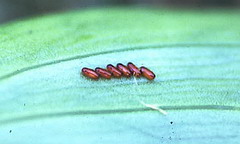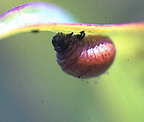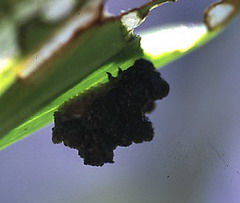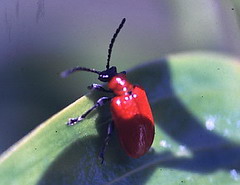|
Red Lily Bug
|
lately, 3-4 years, it seems to be spreading across Eastern Canada and the U.S. with some speed. Why and how are questions that have no real answers and the reality is that most of us are only mildly interested. How to get rid of them is the far more important question.
 Learn The Life Cycle
Learn The Life CycleIt is much easier to attack the enemy when you know its habits. The red lily bug overwinters in the soil as an adult and emerges in the early spring looking for food. If you grow Fritillaria, Crown Imperial, you will be the first to see them as that is their early food of choice, long before the lilies have emerged from the soil. They survive as adults for 2 - 4 weeks and then lay their eggs on the underside of Lily leaves(picture left.)

These eggs hatch into an ugly orange larva stage (picture right) that has a voracious appetite. They can defoliate a large lily in a few days. They become harder to deal with as they age because of a disgusting defense mechanism they have.
 As they devour your lily leaves the Red lily Bug, like all animals, defecate but the lily bug packs all this black goo onto its body so that it becomes unappetizing to predators and to gardeners. Eventually it falls to the soil and pupates for 2 - 3 weeks and the adult reemerges.
As they devour your lily leaves the Red lily Bug, like all animals, defecate but the lily bug packs all this black goo onto its body so that it becomes unappetizing to predators and to gardeners. Eventually it falls to the soil and pupates for 2 - 3 weeks and the adult reemerges.
The literature says that they only produce one generation per year but I have a second set of adults showing up in early July and laying eggs that will undoubtedly produce a second generation this year. I’m not sure where so many adults are coming from because I thought I had very few larva survive my mid-June attacks.
Control?
Manual control of the adult Red Lily Bug is the best defense. They are easy to see and easy to kill. I have a pair of needle nosed pliers that I keep handy and I just walk about and squeeze them. Thumb and forefinger work just as well for the unsqueamish. You can shake them off the plant into a bucket of soapy water where they will perish. Once you are aware of the damage they can cause, there is something sadistically satisfying in the squeeze method. The eggs are easy to spot on the underside of the leaves, (see picture above,) and a simple wipe of the leaves eliminates them. The larva are less satisfying to squeeze. I use ‘Trounce’ a solution of insecticidal soap and pyrethrin as a spray. Very low human toxicity. It is a contact spray with no residual action and therefore must actually be sprayed on the bugs. They are big and slow moving so that is quite easy. Lots of people have suggested Neem oil but I have not tried it and it is not as readily obtainable.

Success
I grow quite a number of lilies with reasonable success. I don’t win prizes at the fair because there are a few holes in the leaves but the lilies thrive and increase every year. It’s up to each of you to decide if your love of Lilies is worth the control routine. It’s really just a small part of my morning walkabout, to spot the bright red bugs and eliminate them.
You can search my entire site for answers to your other gardening mysteries.

